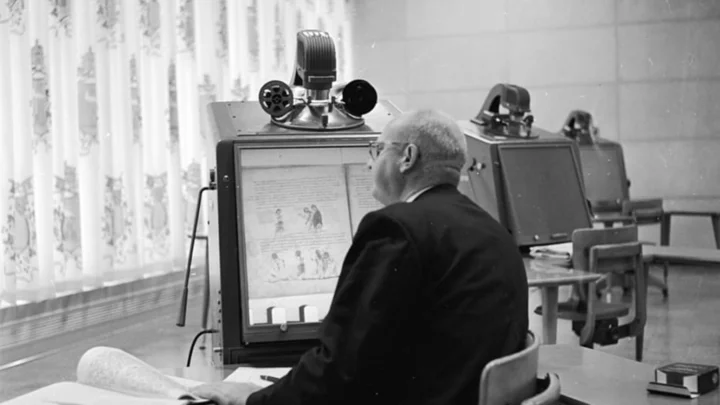The early 20th century saw a revolution in entertainment. Connoisseurs of the arts no longer had to go to the playhouse to see dramas or the concert hall to hear music. Cinemas projected movie stars onto massive screens, and phonographs piped recordings of popular songs into people’s homes. Print books, however, were harder to reinvent. That didn’t stop one enterprising artist from envisioning the first e-book nearly 70 years before its time.
American writer Bob Brown was inspired to bring the written word into the electronic age after seeing a film in 1930. The visual medium was progressing fast, with “talkies” quickly supplanting silent pictures. He felt his medium of choice was falling behind in comparison. “We have the talkies, but as yet no Readies,” Brown wrote. “Writing has been bottled up in books since the start[...] It is time to pull out the stopper.”
His proposal continued with a description of what his so-called “Readies” would look like. Brown’s concept for the machine had many of the same advantages as modern e-readers. It would “allow readers to adjust the type size and avoid paper cuts” as well as “read hundred-thousand-word novels in 10 minutes” if so desired. Instead of e-ink, this would be accomplished by ribbons of tiny text that readers would scroll manually behind a sheet of magnifying glass. An ingenius combination of microfilm and ticker-tape machines, the device would be more cumbersome than a Kindle but still convenient compared to a personal library.
Brown’s idea received attention in the publishing world. Influential writers like Gertrude Stein and Ezra Pound sent him experimental works designed for the format, which he published as an anthology titled “Readies for Bob Brown’s Machine.” He looked into applying for a patent and had a friend build a wooden prototype. But as film continued to advance—with the advent of Technicolor and television within the span of a few years—Readies eventually faded into obscurity, with readers preferring to pick up the newly invented paperback when they wanted something portable.
History would prove that Brown’s invention wasn’t a pie-in-the-sky idea; it merely came too soon. University of Illinois student Michael S. Hart created the first digitized e-book—an electronic copy of the Declaration of Independence—in 1971. The technology went through another evolution in 1998, when Rocket Ebook and Softbook hit the market as the first dedicated, portable e-readers. Major publishing houses started releasing digital versions of their titles in the early 2000s, and in 2007, Amazon released the Kindle and forever changed the game. In the 21st century, Brown’s vision of a papercut-free, electronic reading experience is alive and well—for the most part. We’re still waiting on a technology that makes it easy to read a 100,000-word novel in 10 minutes, though.
This article was originally published on www.mentalfloss.com as Before E-Readers, a 1930s Writer Reinvented the Book With “Readies”.

